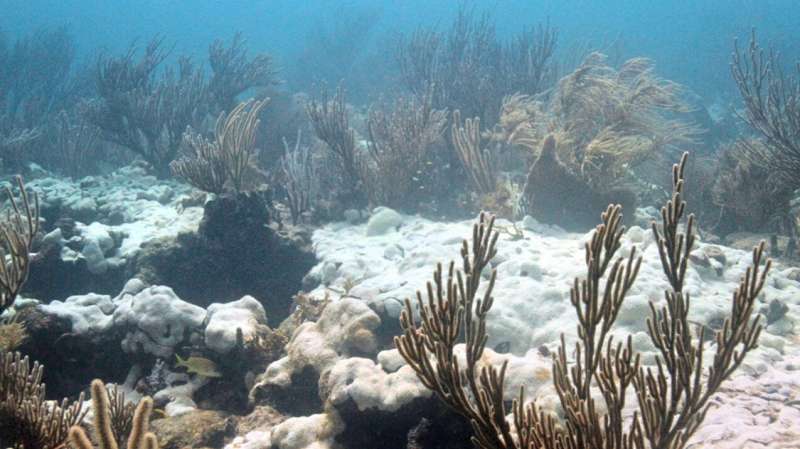This article has been reviewed according to Science X's editorial process and policies. Editors have highlighted the following attributes while ensuring the content's credibility:
fact-checked
trusted source
proofread
Q&A: The ongoing marine heat waves in US waters explained

NOAA scientists have tracked a steady climb in ocean temperatures since April 2023, which is causing unprecedented heat stress conditions in the Caribbean Basin, including waters surrounding Florida and in the Gulf of Mexico.
More isolated marine heat wave conditions have been detected off the Northeast U.S. coast, along the path of the Gulf Stream. NOAA has also been monitoring a large marine heat wave in the Northeast Pacific (in the Gulf of Alaska) that has been sitting offshore since late 2022.
As we gather more data about these events, NOAA scientists are providing answers to big questions about marine heat waves.
What are marine heat waves?
Marine heat waves are usually defined as any time the ocean temperature is above the 90th percentile for a specific length of time. This means that the temperatures are warmer than 90% of the previous observations for a given time of year. Marine heat waves can last for weeks, months or years. Marine heat wave conditions are monitored by NOAA's Physical Sciences Laboratory (PSL) and NOAA Coral Reef Watch.
How are marine heat wave observations and measurements made?
The National Weather Service's National Data Buoy Center collects and disseminates real-time quality-controlled marine observations using 1,300 weather observing stations. Global ocean surface temperatures are also monitored daily using blended satellite measurements.
Why is this marine heat wave in South Florida significant?
In the last week (as of this writing), water temperatures throughout the Gulf of Mexico and in the Caribbean Sea have been approximately 1.8–5.4°F (1–3°C) warmer than normal. Temperatures around Southern Florida are the warmest on record (going back to 1981). The latest conditions can be seen on the NOAA PSL Map Room webpage.
Given that we are in the thick of the Atlantic hurricane season and the tropical North Atlantic is already warm, extremely warm ocean temperatures in the Caribbean and the Gulf of Mexico are concerning. Developing tropical storms that pass into the region may strengthen as a result of these conditions. The ongoing marine heat wave in South Florida could impact sensitive marine ecosystems in the region, such as shallow water corals.
How long has the marine heat wave been going on? How long will this heat wave last?
The current Gulf of Mexico marine heat wave has been present for several months, beginning in February/March of 2023. NOAA's experimental marine heat wave forecasts indicate a 70%–100% chance that extreme ocean temperatures will persist in the southern Gulf of Mexico and Caribbean Sea through at least October 2023. We have low-to-medium confidence in this prediction given the historical skill of the forecasting system in these regions.
What role does climate change play in this marine heat wave off Florida?
The ocean absorbs 90% of the excess heat associated with global warming. As a result, we know that marine heat waves all over the planet are becoming warmer over time. The absolute temperature of the current event is warmer because of climate change, but it would have likely still occurred without climate change.
Warming trends also impact our marine heat wave prediction systems, typically by increasing the probability of marine heat waves in our forecasts.
How are corals and marine ecosystems impacted by marine heat waves?
Marine heat waves cause stress to corals and other marine ecosystems. Exposure to extreme temperature for long periods of time causes a breakdown in the relationship between coral and the algae that live inside of them. The coral is left pale or white, i.e., bleached. The lack of food from the algae can lead to the death of the coral.
If the heat stress does not subside, the coral will die. Mortality becomes likely if the corals experience ocean temperatures of 1°C greater than the historical maximum monthly average for two months, or 2°C greater than the historical maximum monthly average for one month.
How does NOAA anticipate these marine heat waves may impact fisheries and ecosystems?
Extreme heat can be destructive and deadly for marine systems. An unprecedented marine heat wave known as "the Blob" dominated the northeastern Pacific from 2013 to 2016, and upended ecosystems across a huge swath of the Pacific Ocean. This led to an ecological cascade, causing fishery collapses and fishery disaster determinations.
"The Blob" caused whales' prey to be concentrated unusually close to shore, and a severe bloom of toxic algae along the coast delayed opening of the valuable Dungeness crab fishery. Humpback whales moved closer to shore to feed in some of the same waters targeted by the crab fishery, resulting in a then-record 53 whale entanglements in 2015 and 55 in 2016.
Provided by NOAA Headquarters





















